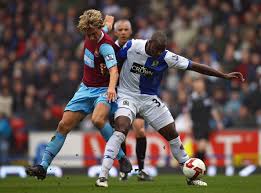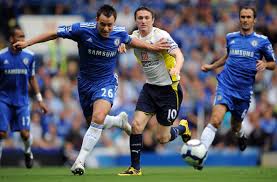 |  |  |
English Premier League
England
The Barclays English Premier League (EPL), considered as the best in the world.
Blackburn Rovers vs Tottenham Hotspur
Official name Blackburn Rovers FC
City Blackburn
Founded 1875
Club colors Blue-White / White / White
vs.
0 - 0
Tottenham Hotspur
Official name Tottenham Hotspur FC
City Tottenham
Founded 1882
Club colors Navy Blue / White
Match scheduled:
Date: 19-12-2009
Time: 15:00 until 17:00
Week 18 / Round 18 :: Barclays Premier League 2009/2010
Return to the Premiership and League Cup success
In 2001–02, Blackburn record signing Andy Cole was bought in for £8million, as was Turkish playmaker Tugay Kerimoglu, Italian hotshot Corrado Grabbi and full back Lucas Neill were signed to strengthen an already solid squad. With David Dunn and Damien Duff both shining, the season was a memorable one. More significantly, Blackburn Rovers won their first-ever League Cup by beating Tottenham Hotspur 2–1 at the Millennium Stadium in Cardiff - where Cole proved his worth by scoring the winning goal in the 69th minute after Matt Jansen had put Rovers in front. Their cup success meant a place in the UEFA Cup for 2002-03
The following season, Souness signed Dwight Yorke from Manchester United, as Matt Jansen was involved in a motor cycle accident during pre-season that left him with serious head injuries. Blackburn Rovers progress continued as they finished sixth on the last day, with an impressive 4–0 win away at Tottenham, to qualify for the UEFA Cup for the second season running. Again it was Duff and Dunn who shone brightest, while goalkeeper Brad Friedel was one of the league's best players, However, the club had to be content with a disappointing exit from the UEFA Cup to eventual finalists Celtic, despite this, the club went into the 2003-04 with great expectations.
At the start of 2003–04 the sale of fan favourites Damien Duff and David Dunn meant that Rovers were always going to struggle to emulate the previous season's form. With transfer funds would be available, Souness replaced Duff with the highly rated Australian winger Brett Emerton from Feyenoord and Stephen Reid, while Lorenzo Amoruso, the Rangers defender, was also signed. Henning Berg was among the other departures. The season started promisingly, as newly promoted Wolverhampton Wanderers were defeated 5-1 at Ewood. The signing of Rangers captain Barry Ferguson for £7.5 million prompted talk of a surprise title challenge. However, results dipped, and the club began a long sequence of home defeats that left them in towards relegation danger. Souness's job was put on the line, and the club eventually were left needing a late turnaround, inspired by little known striker Jon Stead, to avoid relegation back to the English first division. 15th place was secured by a run of 4 wins from the final 6 games, sparked by a 4-3 victory at Fulham.
Mark Hughes era (2004–2008)
Souness left just after the start of 2004-05 to take charge at Newcastle. Rovers appointed Welsh national coach Mark Hughes as his successor, a key player in the club's promotion and League Cup successes a few seasons earlier. Hughes secured Rovers Premiership survival for the 2004–05 season as well as an FA Cup semi-final against Arsenal, with Rovers finishing 15th once again, with Hughes's arrival coinciding with the team becoming one of the most solid teams in the league, thanks to astute signings such as Ryan Nelsen and Aaron Mokoena, and good motivational skills. He was able to strengthen the setup for 2005–06 with the £3.2 million transfer of much sought-after Wales international striker Craig Bellamy from Newcastle United. Following a 1–0 victory over league champions Chelsea F.C., Blackburn Rovers secured the 6th place in the league and a spot in the UEFA Cup for the 2006–07 season - their third European qualification in five years, and their sixth foray into Europe since 1994.
After qualifying for Europe, Rovers signed South African striker Benni McCarthy from Porto as a replacement for the departing Craig Bellamy. Blackburn Rovers finished top of their group and were drawn against Bayer Leverkusen; they suffered a narrow 3–2 defeat in the first leg of their tie against Bayer Leverkusen, but a 0–0 draw in the second leg saw them bow out of the competition. The club was busy during the January transfer window, signing David Dunn, Stephen Warnock, Christopher Samba and Bruno Berner. Rovers reached the Semi Final of the FA Cup in 2007, they defeated Everton, Luton, Arsenal (after replay) and Manchester City. However they would go on to be defeated by Chelsea in the semi-final, with the game going into extra time. Rovers finished the season 10th in the league, with McCarthy netting 18 league goals. The club also qualified for the Intertoto Cup, which they successfully came through.
To prepare for the 2007–08 season Rovers invested in three new players, signing Paraguay international Roque Santa Cruz from Bundesliga giants Bayern Munich, Dutch under-21 star Maceo Rigters and young goalkeeper Gunnar Nielsen. Blackburn would be knocked out of the UEFA Cup by Greek team Larissa, and also suffer a defeat to Coventry, in the FA Cup. Rovers confirmed an application to the following season's Intertoto competition. However, Blackburn lost 4-1 to Birmingham City on the final day of the season to deny them the Intertoto spot, which went to Aston Villa. Rovers ended in a respectable 7th. position in the Premiership, their third consecutive top half finish.
Hoddle turned to more experienced players in the shape of Teddy Sheringham, Gus Poyet and Christian Ziege for inspiration, and Spurs played some encouraging football in the opening months of his management. Season 2001–02 saw Spurs finish in ninth place, as well as reaching the League Cup final, where they lost to Blackburn Rovers, having been the favourites after their 5-1 demolition of Chelsea in the previous round.
The only significant outlay prior to the following campaign was £7 million for Robbie Keane, who joined from Leeds United. 2002–03 started well, with Tottenham in the top six as late as early February, but the season ended with a 10th place finish being the result of a barren final 10 games of the league campaign that delivered a mere 7 points. Several players publicly criticised Hoddle's management and communication skills. Six games into the 2003-04 season, with Spurs struggling at the foot of the table, Hoddle was sacked and David Pleat took over on a caretaker basis until a permanent successor could be found.
In May 2004, Tottenham appointed French team manager Jacques Santini as head coach, with Martin Jol as his assistant and Frank Arnesen as Sporting Director. Santini quit the club in bizarre circumstances in early November. He was replaced by Jol, who turned things around and secured a ninth place finish. In June 2005, when Arnesen moved to Chelsea, Spurs appointed Damien Comolli as Sporting Director.
During 2005–06 Spurs spent six months in the top four, going into the final game of the season, they led rivals Arsenal by a point, but were forced to play their match at West Ham with half the team suffering from Norovirus, a viral form of gastroenteritis, commonly known as "Winter Vomiting Disease". Spurs lost and were pipped to a Champions League place, but it was success nevertheless in gaining a place in the UEFA Cup. They finished fifth for the second season in a row in 2006–07.
Martin Jol was sacked early into the 07–08 season, with Juande Ramos ex-Seville coach replacing the Dutchman. Spurs went on to win the Football League Cup, beating Chelsea 2-1 in the final in February 2008.[2] However, Tottenham endured another dismal start to the season in 2008-09, and in late October a UEFA Cup defeat by Italian side Udinese, combined with terrible league form that saw them bottom of the Premier League, Commoli and Ramos were both sacked. 2008-09 saw the worst start to a season in the club's history.[3] The following day Portsmouth Manager Harry Redknapp confirmed that he had agreed to become the new manager of Tottenham.[3] Director of Football Damien Comolli was also sacked, after criticism of the sales of Dimitar Berbatov and Robbie Keane and failure to replace them adequately. Tottenham returned to a "traditional" setup with Redknapp in charge of coaching and player transfers.[3][4][5] In his first two weeks in charge, Redknapp took the club out of the relegation zone, winning ten out of the twelve points available with wins against Bolton, Liverpool and Manchester City and a 4–4 draw against North London rivals Arsenal. The team finished the 2008-09 campaign 8th in the league table. The January transfer window saw the return of Robbie Keane to the club after an unsuccessful six-month spell at Liverpool.
Spurs have won the first four matches of the 2009–10 season, with Redknapp subsequently awarded the Manager of the Month award and Jermain Defoe the Player of the Month award for August.[6] On 22 November 2009, Spurs beat Wigan Athletic 9–1 at White Hart Lane – a record win in the top flight for the club.[7]
White Hart Lane was originally a disused nursery owned by the brewery Charringtons and located behind a public house. The landlord realised the increased revenues he could enjoy if Tottenham played their matches behind his pub and the club moved in. They brought with them the stand they used at Northumberland Park which gave shelter to 2,500 fans. Notts County were the first visitors to 'the Lane' in a friendly watched by 5,000 people and bringing in £115 in receipts, Spurs won 4-1. QPR became the first competitive visitors to the ground and 11,000 people saw them lose 1-0 to Tottenham.
In 1905 Tottenham raised enough money to buy the freehold to the land and became the permanent owners of the ground. As the club grew new stands were added. A new main stand was added in 1909, the East stand was also covered this year and extended further two years later. The profits from the 1921 FA Cup win were used to build a covered terrace at the Paxton Road end and the Park Lane end was built at a cost of over £3,000 some two years later. This increased the ground's capacity to around 58,000 with room for 40,000 under cover. The East Stand development was finishing in 1934 which increased the capacity to around 80,000 spectators and cost £60,000. The pitch was renovated in 1952 which uncovered a number of items from the old nursery on the site and one year later the first floodlights were introduced. These lights were upgraded in 1957 which required the cockerel to be moved from the West Stand to the East and then in 1961 floodlight pylons were installed.
 |  |  |









